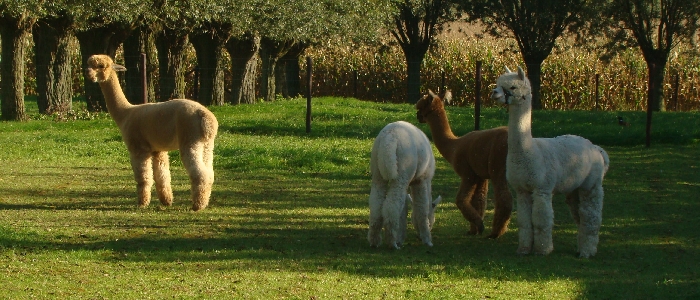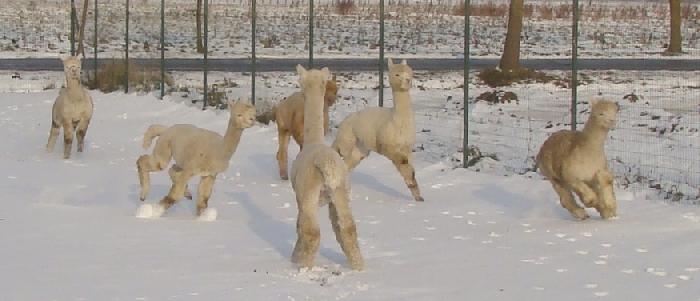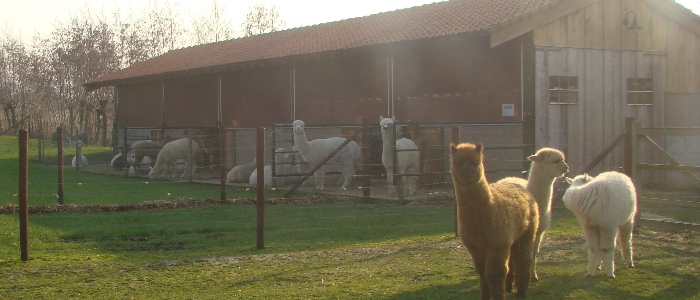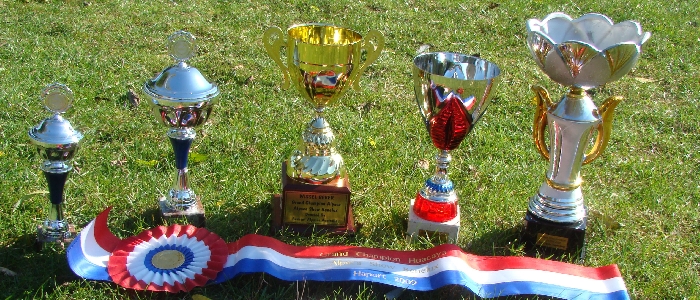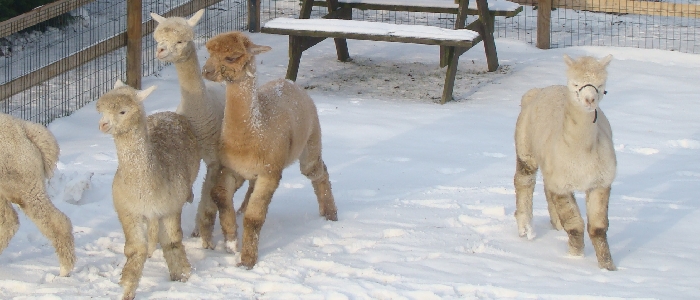Een nieuwe kijk op de vacht
A New View on Fibre
By Nic Cooper, Southern Alpacas Stud
Fibre traits are many, and very few alpacas are strong in all aspects.
Micron and shearweight are generally seen to be the most important in huacaya.
Micron is the fineness of the alpaca, measured as an average fibre diameter (in microns). In developed markets the finer the fibre, the greater price you get for it. Lower micron is better.
However different product lines demand different micron ranges - so if you have a particular product line you intend producing for, that will dictate your micron emphasis.
Shearweight needs little definition. On the animal it is indicated by "density" which is a subjective assessment. Actual shearweight is measured, and usually annualised.
These two traits are contra-indicative - lower micron and higher shearweight do not easily go hand-in-hand. However research has shown that empirical scatter graph plotting will allow identification of certain animals (genetic lines) that tend to hold their density as they are mated for fineness, or conversely hold their fineness as they are mated for density. These alpacas are prized outliers.
Standard Deviation (SD) is a measure of the variation of fibre micron around the mean. Generally the lower the better, but we prefer to measure CV.
Co-efficient of Variation (CV) which is a mathematical result of micron and SD
and which shows the variation of fibre micron consistently for any micron level. Lower is better.
Consistency of micron throughout the fleece is an important factor in processing, and can affect price paid. Sheep have been bred for far greater consistency than alpacas currently display, giving hope for scope to improve.
Spin Fineness (SF) is a calculation that recognises that consistent fleeces (low CV) process better than less consistent ones, and adjusts the micron (fineness) to account for this. SF is therefore a better measure of fibre "processability". Maybe reflecting the more subjective term "handle".
Comfort Factor (CF) measures the % of fibres below 30 micron. It has become somewhat of a "marketing number" for alpacas since it name changed from "Prickle Factor" (PF) which measured the % of fibres above 30 micron. However it is a sheep based calculation, and we know alpaca fibre and sheep fibre are physically different. So is the 30 micron cut off valid in alpaca?
CF is only vaguely a measure of consistency and fineness. We do not use it.
Curve measures the crimp of an alpaca by measuring the degrees the fibre curves in a 1 mm section. (expressed in deg/mm). Curve research is in its infancy - even in the sheep world, however note the following:
* Processors are clear they look for crimp in the fibre they buy, as crimp adds loft to the yarn and allows production of lighter weight garments. This characteristic much in demand in the world today.
* Research in alpaca recently has positively correlated crimp frequency (number of crimps per inch of fibre) with curve. The more crimps per inch, the greater the curve value. (Intuitively logical too)
* Research by Yokum McColl Testing Labs, and by Cameron Holt strongly negatively correlate (0.72 correlation) curve values and fibre fineness (the higher the curve, the finer the fibre).
Whilst alpaca curve (best around 50 deg/mm) is nowhere near merino - this is a fibre driver we are particularly keen on developing and breed towards.
Crimp comes in varying types. It was indeed only 6 years ago alpacas in NZ and Australia did not display crimp at all!
Crimp is defined 2 ways.
* Amplitude (the depth of the crimp, as defined by the curve number).
* Frequency (the number of crimps per inch).
You may have heard the term "deep bold crimp". This is generally high amplitude, low frequency (6 crimps per inch) crimp.
Then there is the "Hemingway" style crimp which is high amplitude, high frequency (10 - 11 crimps per inch) crimp.
Then there is Merino - high amplitude, high frequency (22 crimp per inch) crimp.
Soft Rolling Skin (SRS) is a sheep term that is claimed to reflect animals that are able to pack more secondary follicles per primary follicle in a given skin area. Hence more density, finer, and more uniform fleece. Generally a longer staple length too.
Despite having its afficionados, there is some scepticism in the alpaca and sheep world about whether SRS really gives production value gain.
Lustre is a characteristic more attached to suri alpaca. But huacaya display lustre too - brightness, as light is reflected off the fibre.
Lustre however tends to be more environmentally influenced, and is of course subjective in its measurement.
Uniformity is hugely important in alpacas, as it directly affects production value. Yet so often it is not even mentioned in a purchase/sale situation. There are two ways of seeing uniformity.
First is uniformity within the fleece - whether 90% or 60% of your total shear is first grade. This reduces with the age of the alpaca, but is also widely different from alpaca to alpaca and is the way - these days - champion alpacas are chosen.
Secondly uniformity within your herd. When mixing fleece to make a product, the constituent fleeces should be similar (uniform). Look at your herd statistics, not just individual alpacas.
Uniformity is not just CV!
Some conclusions
The alpaca industry has a long, long way to go when we start talking about fleece, fibre, and products.
Clearly compared to sheep (that have been bred to production targets for nearly 100 years), the alpaca has the potential to improve very significantly over the generations if the proper, focused, and researched breeding plans are consistently followed.
Crimp, curve, and CV clearly have huge gains potential, as probably has shearweight. Micron maybe less so - because huge gains have been made in the last 5 years - although a 13 micron bale of alpaca will not be far off in genetic improvement terms.
The industry also has a long way to go in the development of a (actually several) high class product niche(s) for Australasian alpaca. High quality, high added value, and branded unique from the South American commodity.
This is the challenge ahead for the alpaca. Achievable - but by dedicated breeders with a long term focus, and dedicated fashion product enthusiasts who are prepared to wait to the right time to launch.
Both goals are feasible. But both depend on time, numbers, volumes, and good breeding/business plans.
[2009-02-23 door Nic Cooper]

